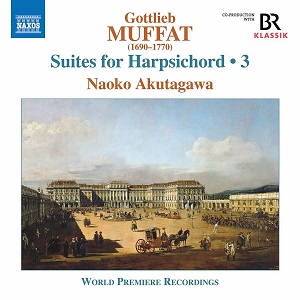
Gottlieb Muffat (1690-1770)
Suites for Harpsichord Volume 3
Suite in A major (MC B36)
Suite in G minor (MC B6)
Suite in D major (MC B7)
Suite in A minor (MC B37)
Suite in D minor (MC B12)
Naoko Akutagawa (harpsichord)
rec. 2021, Bronnbach Cistercian Monastery, Germany
All premiere recordings
Naxos 8.574098 [67]
This CD completes the sequence of three recordings on which Naoko Akutagawa has recorded 11 of the harpsichord suites by Muffat, the best of which (composed from the middle of the 1710s onwards) the composer collected together around 1740. These were amongst the many things which, in Glen Wilson’s ironic words in his booklet essay, were “‘borrowed’ by the Red Army after the Second World War”, having been removed from the library of the Berlin Sing-Akademie. After being hidden in the Kiev Conservatory, these were returned to Germany in 2000; I believe they are now housed in the Berlin State Library.
No one could be better qualified to write the notes for this CD than Glen Wilson; the excellent Naoko Akutagawa, after her studies at the Toho Gakuen School of Music in Tokyo, went on to undertake advanced harpsichord studies with Wilson at the Hochschule für Musik in Würzburg. Furthermore, Wilson was responsible for the modern edition of these suites, published by Breitkopf & Härtel, and was also the producer of these recordings.
The first two volumes in this series were issued in 2013 (Volume 1, review ~ review) and 2019 (Volume 2 review). Elsewhere, Benjamin Katz, writing in American Record Guide, declared of Volume 1 “It is a privilege to hear these works for the first time”, while Colin Clarke (in Fanfare) called Akutagawa’s performances “exemplary”..
I am tempted simply to say that the performances on this disc are every bit as impressive as those on Volumes 1 and 2 and leave it at that. But my conscience tells me that I should say more.
Naoko Akutagawa is one of my favourite harpsichordists, a player who combines technical certainty with imaginative attention both to detail and to larger structural questions. Her judgement of tempo seems infallible and she displays imaginative flair throughout in the use of ornaments, but is never unfaithful to the spirit of the music. Dynamics and colours are varied in ways that always illuminate the development/structure of the music, never being in the slightest way gratuitous. Akutagawa’s fingers can dance – the menuets, courantes, gavottes and ballets in these suites provide abundant evidence of that – and she can make her listener (this one at least) want to get up and dance (something I only ever do in private these days). However, Akutagawa can also do full justice to other elements in these suites, such as the thoroughly grand and dignified Sarabande in the D major suite which, for all its dignity, is here as remote from the ponderous as one could well imagine.
The instrument Akutagawa is playing is a modern copy, by Henk van Schevikoven of Helsinki, of one made by Andreas Ruckers in the first half of the seventeenth century and ‘restored’ by Henri Hemsch in the Paris of the 1760s; this is perhaps/probably the instrument now in the Cobbe Collection at Hatchlands Park in Surrey, or at least one very like it. It seems well suited to Muffat’s French-influenced suites and it is well served by the excellent recorded sound. (The recording – the engineer of which was Jürgen Rummel – was made as a co-production with Bayerische Rundfunk, the public-service broadcaster based in Munich).
If you have, or have heard, the two previous discs in this series, you won’t need any urging to acquire the third and final disc in the set. If not, this would be a good place to start and to enjoy a feast of fine music. The back of the case containing this disc carries the pronouncement that “Gottlieb Muffat was the most important Viennese composer of the 18th century in Vienna”. Though this is surely true, it would be wrong to think that Muffat cannot also stand wider comparison with other masters of the harpsichord amongst his contemporaries – figures such as François Couperin (1668-1733), Rameau (1683-1674) and Handel (1685-1759). Handel thought well enough of Gottlieb Muffat to ‘borrow’ from him on several occasions, and Muffat returned the compliment (see, for example, Bernd Baselt, ‘Muffat and Handel: A Two-Way Exchange’, The Musical Times, Vol. 120, No. 1641, November 1979, pp. 994-97).
All who love the harpsichord music of the baroque should have this disc on their shelves.
Glyn Pursglove
Help us financially by purchasing from




















